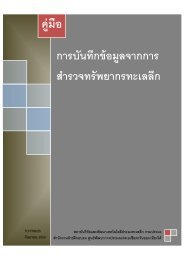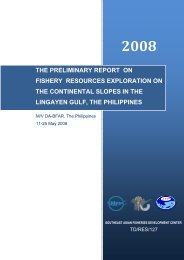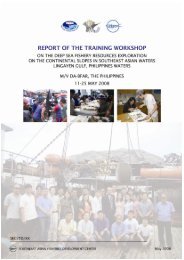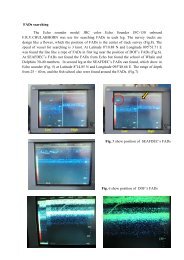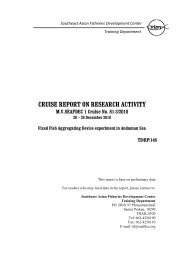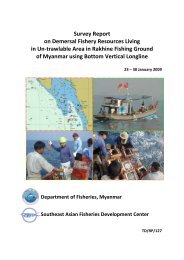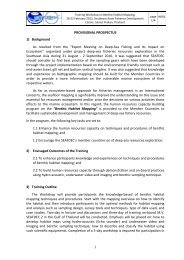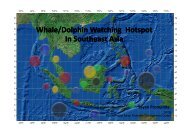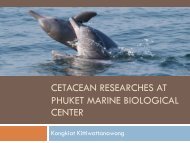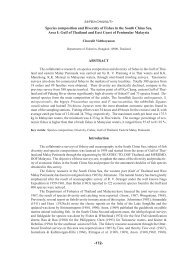Download - fisheries information system - Seafdec
Download - fisheries information system - Seafdec
Download - fisheries information system - Seafdec
Create successful ePaper yourself
Turn your PDF publications into a flip-book with our unique Google optimized e-Paper software.
The Eco<strong>system</strong>-Based Fishery Management in the Bay of Bengal<br />
high natural mortality, high growth rate and significant production (Nesis, 1977). It is very<br />
abundant and recognized as one of the main squid resources in the South China Sea and<br />
especially the northwestern Indian Ocean (Chesalin, 1997; Chesalin and Zuyev, 2002).<br />
Similar to all other squid, purpleback squid is carnivorous, feeding mainly on crustaceans,<br />
small fish, and other cephalopods (Collins et al., 1994; Collins and Pierce, 1996; Quetglas et<br />
al., 1999). Xinjun et al. (2007) found that stomach contents of purpleback squid from the<br />
northwestern Indian Ocean contained three major diet groups: fish, cephalopods and<br />
crustaceans, mainly Cypselurus spp. and S. oualaniensis. More than 60% of the stomachs of<br />
squid larger than 400 mm ML had evidence of cannibalism.<br />
Squid are themselves important prey items for large fish, sea birds, and marine<br />
mammals (Pierce and Santos, 1996; Santos et al., 2001). Squid (and other cephalopods) are<br />
very efficient accumulators of various trace elements (Martin and Flegal, 1975; Miramand<br />
and Bentley, 1992; Bustamante et al., 2002). Toxic metals such as cadmium and mercury are<br />
bioaccumulated and retained in squid (Bustamante et al., 1998, 2006) and consequently passed on<br />
to predators, thus potentially increasing the contaminant load in higher trophic levels,<br />
including humans (Bustamante et al., 1998; Lahaye et al., 2005; Storelli et al., 2005, 2006).<br />
The purpleback squid population in the Bay of Bengal has been recognized as a<br />
potential fishery resource for human consumption. Hence, <strong>information</strong> on heavy metal<br />
concentrations in this squid is important for future policy regarding exploitation of this<br />
species. The aims of this study were to determine and compare heavy metal concentrations in<br />
the edible portion (mantle, arm and tentacle) and visceral mass of purpleback squid<br />
(Sthenoteuthis oualaniensis) from nine sampling stations in the Bay of Bengal.<br />
Materials and Methods<br />
Samples of purpleback squid were caught by two Japanese automatic squid jigging<br />
machines which were fixed and operated at the starboard side of the fishery research vessel<br />
M.V. SEAFDEC, of the Southeast Asian Fisheries Development Center (SEAFDEC). The<br />
squid were attracted by 500 kilowatt light from 15 halogen lamps fixed along the starboard<br />
side of the ship at a height of 10 m from the surface of water. The lights were switched on 60<br />
minutes before the start of sampling. Collection occurred from 20.00-24.00 PM. for every<br />
sampling event. Seven of the sampling stations (1, 3, 7, 8, 9, 10 and 12) were located within<br />
area C, or the eastern part of the Bay of Bengal (Fig. 1). Two other sampling stations (14 and<br />
16) were located at the northern part of the Bay (area A; Fig. 1). A list of sampling stations<br />
and their positions can be found in Table 1.<br />
Mantle length and body weight of each individual caught were measured and<br />
recorded. Sex of the squids was determined by the presence or absence of a hectocotylus<br />
(modified ventral arm of the male). Each squid was placed in a plastic zip-log bag and kept<br />
frozen until analysis.<br />
Prior to heavy metal analysis the samples of purpleback squid were thawed at room<br />
temperature. Three individuals from each sampling station were randomly chosen for the<br />
analysis, except for station 3, in which only one squid was available. The edible body parts<br />
(mantle, arm and tentacle) and visceral mass of each squid were separated. The samples were<br />
cut and homogenized in a blender. A 1.0-1.5 g portion of each homogenized sample was<br />
carefully weighed in a Teflon vessel. Hydrogen peroxide and sub-boiled distilled nitric acid<br />
was added to the vessels. The vessels were then closed tightly and placed in a microwave<br />
digester (CEM; Mar5x). Afterwards, the samples were cooled down and diluted with<br />
deionized water. Mercury (Hg) concentration in the digested sample was determined by Cold<br />
Vapor Atomic Fluorescence Spectrometer (PSAnalytical; Merlin) whereas Cd, Pb, and Cu<br />
were determined by Graphite Furnace Atomic Absorption Spectrophotometer (Unicam;<br />
234



